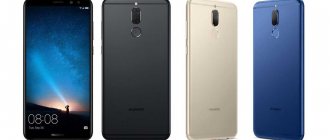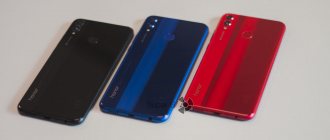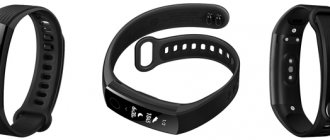The Honor brand (previously a budget sub-brand of Huawei, and now a full-fledged player with a good line of smartphones) is known for its inexpensive but high-quality smartphone models. For example, Honor 9 is not much inferior to more famous flagships except for price. Therefore, when you pick up the Honor 6A with a price tag of 8,990 rubles, you are pleasantly surprised by the metal body, bright IPS screen and fairly powerful Snapdragon 430 processor. As a result, we have a good workhorse at an adequate price.
Let's start with the stated characteristics:
- Processor: Snapdragon 430, 8 x 1.5 GHz Cortex-A53
- Graphics: Adreno 505
- screen: 5 inches, IPS, resolution 1280×720
- RAM: 2 GB
- Built-in memory: 16 GB
- battery: 3020 mAh
- Fingerprint's scanner
- OS: Android 7.0; EMUI 5.1 shell
- memory card support: microSDXC up to 128 GB
- SIM: two nano-SIM slots (one can be replaced with an SD card)
- cellular communication: GSM 850/900/1800/1900 MHz; UMTS 900/2100 MHz; LTE Band: 1, 3, 7, 38, 39, 40, 41
- wireless networks: Wi-Fi 802.11 b/g/n, Bluetooth 4.1
- navigation: GPS, GLONASS
- cameras: front - 5 MP; main — 13 MP
- dimensions: 143.7x70.95x8.2 mm
- weight: 143 grams
- charging and synchronization: MicroUSB (USB 2.0)
- NFC: no
- fast charging: no
As can be seen from the specification, “budget” had an impact on screen resolution, the amount of RAM and the lack of NFC. On the other hand, it is almost impossible to find a device in Russian retail with a similar price and the same characteristics. Of the devices available for order on various websites, this device can only be compared in price to the Xiaomi 4X. But in Russia it costs about 11 thousand rubles, and when ordering from China, there is a problem with the guarantee and there may be difficulties with customs clearance.
Appearance
Thanks to the metal body, the device does not look like a budget device. But other than this, he is, perhaps, no different from thousands of his brothers along the diagonal.
The photomodule extends 1 mm beyond the body and is carefully surrounded by a metal frame. The fingerprint sensor is located slightly lower, it works quickly and flawlessly.
The screen cannot be called something outstanding. However, despite the resolution of 1280x720 pixels - which, frankly, at this diagonal is not much different from FullHD - it copes well with displaying both photos and text. The IPS matrix itself is quite bright and has good viewing angles.
Unfortunately, due to price restrictions, the manufacturer still had to save on something. Therefore, the screen has an air gap between the protective glass and the display and is completely devoid of oleophobic coating. This affects the image quality, but, again, the screen looks decent compared to its peers at the same price.
Automatic brightness adjustment also has a hint of budget and regularly makes mistakes.
⇡#Display and sound
The Honor Pad V6 has a 10.4-inch LCD display with an IPS matrix. Resolution - 2000 × 1200. Pixel density - 225 dpi: some pixelation in fonts is noticeable.
The touch coating responds to 10 simultaneous touches. The oleophobic coating is good - even if the glass readily collects fingerprints, wiping them off with any available cloth is not difficult.
In the screen settings, you can activate vision protection (a mode with the warmest colors), a dark interface mode, set the so-called smart resolution (the tablet works in Full HD resolution by default, but switches to 2K when it “feels” the need for it), and also adjust color rendering. There are no presets; you can adjust the color temperature to suit yourself and activate the “natural tone” mode, which changes the color rendition of the display depending on the external lighting. By default, the tablet works with the “natural tone” mode disabled.
The measured maximum brightness level is 494 cd/m2 - an excellent indicator for an LCD matrix. The tablet can be safely used not only indoors, but also outdoors in bright sunlight. The contrast level for the LCD display is normal - 1314:1.
Honor Pad V6, gamma. Yellow line – Pad V6 indicators, dotted line – reference gamut
Honor Pad V6, color temperature. Blue line – Pad V6 indicators, dotted line – reference temperature
Honor Pad V6, color gamut. Gray triangle – sRGB coverage, white triangle – Pad V6 coverage
When the “natural tone” mode is turned off, the picture has a pronounced cold tint. At the same time, the color gamut corresponds to the sRGB standard – the Honor Pad V6 screen does not pretend to have a wide gamut. The average gamma is slightly below normal - 2.08, the curves behave acceptable. The color temperature is increased - approaching 8,500 K. The average deviation for the expanded Color Checker palette (shades of gray + a wide range of color shades) is 5.63, with the upper limit of the norm being 3.00.
Honor Pad V6, gamma in “natural tone” mode. Yellow line – Pad V6 indicators, dotted line – reference gamut
Honor Pad V6, color temperature in natural tone mode. Blue line – Pad V6 indicators, dotted line – reference temperature
Honor Pad V6, color gamut in natural tone mode. Gray triangle – sRGB coverage, white triangle – Pad V6 coverage
In the “natural tone” mode, colors inevitably warm up, and this does not depend on the conditions. But for information: I measured the Honor Pad V6 display in fairly bright artificial light. The color gamut does not change during automatic color adjustment - it also absolutely complies with the sRGB standard. Gamma already falls within the normal range - 2.1, but the curves behave in a similar way. The color temperature is close to the standard - 6,700-6,900 K with a perfectly smooth graph. The average deviation DeltaE for the Color Checker palette is close to normal - 4.61. The Honor Pad V6 cannot become a reference device for designers, but overall the screen of this tablet is set up well.
Unfortunately, the Honor Pad V6, as is now common, is free of an analog audio jack, although why this should be done in a tablet is completely unclear to me. Wireless data transfer via Bluetooth 5.1 with LDAC support is available (aptX is not here). But there are no questions about external speakers - there are four of them and they are good.
Performance
As mentioned at the beginning, the “heart” of the smartphone is the proven Qualcomm Snapdragon 430. You don’t expect any performance records from the processor, but it copes with normal work well.
It is curious that CPU-Z identifies the chip as Snapdragon 435. It differs from the 430 in a slightly higher nominal clock frequency of 1.4 GHz versus 1.2 GHz, and big.LITTLE architecture (which allows for additional energy savings). Otherwise they are almost identical. However, the manufacturer could overclock the 430 to 1.4 GHz, which is why CPU-Z mistook it for the 435 chip.
The Adreno 505 GPU doesn’t have enough stars in the sky, but it confidently carries 3D games. For example, HearthStone starts without problems and hardly slows down, tanks also start up.
But what there are complaints about is the operation of the proprietary EMUI 5.1 shell. Huawei managed to make a very decent and beautiful add-on over regular Android, which compares favorably with many similar shells. There is also convenient navigation through applications with the ability to select shortcuts both in the iPhone style (all on the desktop) and in the usual Android form. And multi-window mode. Plus, EMUI 5 brings out a number of settings that are either hidden deep under the hood in stock Android or are completely absent. So, for example, EMUI analyzes energy consumption and itself advises the user which application is best to disable if it consumes too much energy. As a result, the convenience of managing the phone, especially for a less savvy user, increases noticeably.
https://youtu.be/9EmRPFC9FnA
?t=12s But, obviously, EMUI 5 was created for more powerful smartphones with more memory. As a result, freezing of the operating system is periodically noticeable, especially if the number of installed applications exceeds the second dozen.
Here, by the way, one caveat must be made - the friezes are noticeable until the application is launched. That is, as soon as the system’s focus shifts to the application, everything goes fine. Well, since we previously talked about a competitor in the form of Xiaomi 4X, here’s what their head-to-head comparison of operating speed looks like, made by Chinese users:
https://www.youtube.com/watch?v=sAnfSHr6Rqg
Huawei Honor 6 review
Huawei Honor 6 is positioned as a mid-level solution. The smartphone was announced in June 2014. This device has a very powerful filling, as well as a somewhat simplified design, but with its own twists.
Appearance and ergonomics
The streamlined body is distinguished by smooth corners and edges. There is glass, but only on the front side. But the side edges turned out to be plastic. The same applies to the back panel, which looks glass, but is actually made of plastic, which is somewhat surprising. The body is quite thin, but it does not always fit perfectly in the hand. The nuances of the design matter. Thanks to the monolithic body, there are no creaks, and the assembly is almost perfect. There is also a frame decorated with metal, which reaches the bottom end. The body itself is made of composite materials, some of which are even used in astronautics. Six separate layers create a deep, rich texture. Honor 6 dimensions: height - 139.5 mm, width - 69.8 mm, weight - 130 g, thickness - 7.5 mm. Color: white and black.
Display
The Honor 6 smartphone is equipped with a 5-inch display with Full HD resolution. The screen is covered with Gorilla Glass 3 to prevent scratches and other defects. There is a high-quality oleophobic coating that does not leave fingerprints. Due to the highest pixel density per inch (440), the picture looks detailed and clear. There is no air gap here, so the image is striking in its naturalness. It is also worth highlighting good saturation and color rendition. Viewing angles are wide, but when tilted, yellow and purple hues dominate. High brightness makes it possible to use the gadget in absolutely any conditions.
Hardware and performance
For a wide variety of tasks, 3 GB of RAM is more than enough. Huawei Honor 6 also has 16 GB of internal memory for user files and system needs. MicroSD cards up to 32 GB expand your available storage space. It uses Android 4.4 OS along with the proprietary EMUI 2.3 shell.
The device from Huawei has a Kirin 920 chip with eight cores. The first four Cortex-A15 cores operate at 1700 MHz, and the second quartet of Cortex-A7 cores operate at 1300 MHz. The Mali-T628 MP4 accelerator with a frequency of 600 MHz is responsible for displaying graphics. Many games run without crashes, and lags are rare. But in some games with advanced effects, certain slowdowns are present. In AnTuTu, the Honor 6 model scores 40,000 points.
Communication and sound
Listening to music through an external speaker in Huawei Honor 6 is a real pleasure. There is bass and the volume level is high. The speaker is of high quality, but its volume reserve is still not enough. The good news is that there is LTE Cat6, which allows you to count on maximum speed in 4G networks.
Camera
Honor 6 uses a truly advanced 13-megapixel camera with an excellent aperture ratio of 2.0. The color reproduction is very high quality, and the detailing is at a decent level. Focusing is instantaneous, and there is also a dual flash of different colors. This is one of the best cameras in this segment. But the video is recorded quite ordinary, but with excellent sound. For portraits, the 5-megapixel front module will definitely come in handy.
conclusions
Huawei Honor 6 turned out to be a complete hit. For 17,000 rubles (initial cost), the user picks up a well-built smartphone with excellent characteristics. The device has few competitors that are able to compete with it in many respects.
Pros:
- Camera.
- Screen.
- Performance.
- Sound.
- Price.
Minuses:
- Shooting video.
- Ergonomics.
Camera
The camera, alas, is the weakest link where the savings are especially noticeable. Stated characteristics:
- main camera 13 megapixels with f/2.2 aperture;
- front: 5 MP
In bright light conditions, the photos turn out quite well, especially if you look at them on the same smartphone.
If you expand the resulting image on a full-fledged monitor, it becomes obvious that the software built into the camera is diligently “washing up” the image.
This is done, apparently, so that photographs taken in low light conditions do not appear too noisy. Well, in general, the general Chinese trend towards a kind of retouching of the surrounding reality is affecting.
Evening or night photography is not possible for this smartphone at all. Alas, this is the price that you have to pay, pardon the pun, for the price of the phone.
However, by swiping left in the proprietary camera application, the so-called “professional mode” opens, allowing you to play with the focus or extend the photo a little due to more subtle settings.
As for video, everything is also standard: Full HD with 30 frames per second.
⇡#Design, ergonomics and software
It's not that difficult to make a frameless tablet, but it's a pretty pointless task - since you still have to somehow hold the device in your hands, you inevitably touch the display around the edges. Therefore, no serious movement is happening in this regard - tablets “from the outside” look in 2021 about the same as, for example, in 2015.
At the same time, purely in terms of numbers, the Honor Pad V6 outperforms its competitors - the thickness of the frames here is 7.9 mm. But this is information for press releases, and in fact you will not feel the difference when compared. Perhaps the dimensions will be slightly smaller, but again not significantly. Well, we have already seen tablets with thinner frames - Huawei Matepad Pro, for example. There, this forced them to burst into the space of the screen with the front camera, which for a multimedia device, if not like death, then at least undesirable. In Honor Pad V6, the camera fits into the frame - nothing will get in the way when watching videos or playing games.
Honor Pad V6, front panel: above the screen - front camera and charging indicator
Honor Pad V6, rear panel: in the corner there is a unit with a camera, flash and microphone
The back panel is made of plexiglass, painted black. More precisely, Honor calls it black (“midnight black”), but in fact it’s more of a dark gray. The glossy surface plays beautifully in the sun, but does not collect fingerprints very well - and in this case it cannot be sent to the case, as happens with smartphones.
Honor Pad V6, top edge: two microphones and volume key
Honor Pad V6, bottom edge: memory card slot
In the corner there is a rear camera block - you may get the impression that there are several lenses here, as is customary for mobile devices these days, but no, there is only one lens. The second circle is a flash. There is also a microphone here. Despite the relatively thick case for a tablet (7.8 mm), the block protrudes slightly above the body. Sometimes it seems that this is done simply because it is customary, and not because it is impossible to hide the camera entirely in the body.
Honor Pad V6, left side: power/lock key and two speakers
Honor Pad V6, right side: two speakers and USB Type-C port
On the edges there are hardware keys (power/lock and volume controls), a USB Type-C port, quad speaker arrays, and a slot that appears to be designed for SIM cards. In fact, this is a tray exclusively for a memory card - the version with support for mobile networks has not reached Russia.
There is no fingerprint scanner in the Honor Pad V6. The device can either be “password-protected” according to the classics, or you can install an unlocking system using face recognition - the front camera is used for this.
Screenshot gallery
View all images (17)The Honor Pad V6 uses an open version of Google Android 10 - without integrated Google services, but with the proprietary Magic UI 3.1 shell. We have described all the features of such a solution more than once in reviews of Honor smartphones (from the latest, for example, Honor 30i or Honor 30 Pro+): you need to use the company’s AppGallery store, and download the missing ones in the form of apk files on third-party services and using the built-in Petal Search application . For a tablet, you just need to make an allowance that a significant part of the applications missing from post-sanction devices are not so necessary here - the multimedia device remains quite functional and has a limited set of software.
It becomes a little more difficult if you perceive the Honor Pad V6 as a device for creativity - there are no Adobe applications in the AppGallery yet, but, for example, Lightroom or Photoshop were installed through Petal Search. And they work, that is, they are not too dependent on Google services - which, unfortunately, happens with many games installed in the same way (the problem is with the payment system through Google Play). But overall, the Honor Pad V6 remains a fully functional device, even taking into account the sanctions.
There are also several interesting features specific to the tablet version of Magic UI. Multi-window mode - you can display the windows of several applications simultaneously on the screen, either side by side or on top of each other. True, it is stated that you can open up to three windows, but I couldn’t open more than two at the same time. Honor clarifies that this depends on specific applications - some support this feature, and some do not. The App Multiplier function allows you to open several windows at once for one application - but so far it is limited to a not too numerous list of supported programs. Well, there is the already well-known “Multiscreen”, in which the tablet can be used as an additional screen for a smartphone. I’ll also add about the “Children” mode with special screen settings (UV radiation filtering, notifications about incorrect posture, brightness correction, etc.) with the ability to adjust the duration of the session and lock the rest of the tablet.
Network and GPS
The built-in Wi-Fi adapter works using Wi-Fi 802.11 b/g/n protocols, but despite the presence of the “n” index in the name, it does not operate in the 5 GHz band.
However, the sensitivity of the adapter is quite good - it easily clings to the access point even from the far corners of the apartment. With GPS, everything is also good - after a reboot, it took 16 seconds to find satellites.
As for LTE, there is a not very pleasant surprise here - the device does not support the fairly common Band 20. Fortunately, other bands work without problems, which allows the device to surf the network quite quickly.
⇡#Hardware and performance, wireless connections
The Honor Pad V6 has a very powerful hardware platform - HiSilicon Kirin 985. This is an upgraded version of the year before last Kirin 980, with a 5G modem, new graphics and a slightly increased frequency. One of the versions of Honor Pad V6 for the Chinese market, as you might guess, has a compartment for SIM cards, and it can work with networks, including - a huge rarity for a tablet - 5G. But this is not our case. But the Honor Pad V6 presented here can work with the high-speed Wi-Fi 6 standard, which is gradually coming into our lives, and this can be a big advantage, primarily for those who like to play online on a tablet.
Kirin 985 consists of eight cores: main ARM Cortex-A76 clocked at 2.58 GHz + three ARM Cortex-A76 clocked at 2.45 GHz + four ARM Cortex-A55 clocked at 1.84 GHz. Graphics subsystem – ARM Mali-G77. Technological process – 7 nm.
As is clear from the results of synthetic tests, the Honor Pad V6 is a very powerful tablet that will not only run all basic or graphical applications perfectly, but will also perform well in games.
The Honor Pad V6 does not have any noticeable problems with throttling. The cooling system here is of high quality; the CPU Throttling test revealed a decrease in frequency to 87% of the maximum with an average performance level of 178 GIPS.
Honor Pad V6 comes with 6 GB of RAM and 128 GB of non-volatile memory.
You can optionally add up to 512 GB of memory using a microSD card.
Bottom line
Honor 6A turned out to be a very high-quality budget phone.
Where other manufacturers use MediaTek processors, here is the Snapdragon 430. Where other companies still use the old Android, the 6a uses the seven. And finally, where most have cheap plastic, Honor has a durable metal body. Yes, this phone has a number of objective shortcomings due to the desire to fall into the budget price range of up to 10,000 rubles. However, if you look around, it turns out that Honor 6A has practically no competitors. Well, these shortcomings are rather a distinctive feature of its class.











